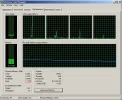- Thread Author
- #1
Hi all,
I have been doing allot of research on Win7's Task Manager, in particular the Performance Tab because I am getting issues I am not understanding.
What I understand:
Can anyone explain in more detail or suggest a link about these values I would be most grateful.

Many thanks,
Nick.
I have been doing allot of research on Win7's Task Manager, in particular the Performance Tab because I am getting issues I am not understanding.
What I understand:
- Total: amount of RAM installed on your computer
- Cached: amount of physical memory used recently for system resources (SuperFetch).
- Available: total of standby and free memory from the Resource Monitor
- Free: amount of memory that is currently unused or doesn't contain useful informatio
Can anyone explain in more detail or suggest a link about these values I would be most grateful.

Many thanks,
Nick.